Nate Silver at FiveThirtyEight posted this graph showing Americans’ faith in various institutions (from the 2008 General Social Survey):
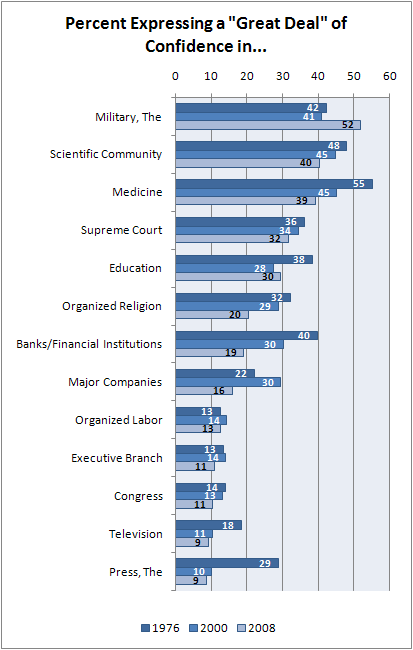
Nate Silver at FiveThirtyEight posted this graph showing Americans’ faith in various institutions (from the 2008 General Social Survey):

People in Muslim countries don’t think so:
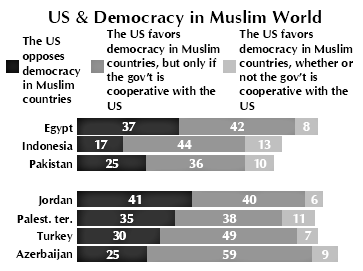
(worldpublicopinion.org, via Kevin Drum at Mother Jones and Alas a Blog).
[youtube]https://www.youtube.com/watch?v=pPuIuYDDwBs[/youtube]
(Via Jezebel.)
Also interesting… I don’t think we have a concept of “swollen noodles” in the U.S.
Also in the sexualization of food:
1. Chex Mix gives you curves.
2. Sexy hot dog lady in a bun.
3. Hot Indian Chicken.
4. Sno-Ball head, sexy lady body.
5. Chopsticks plus fork = hot sex.
6. Vegetables are hot.
7. Pasta, naked lady.
8. Women prefer Kellogs to hot men.
9. Axe makes women love you like chocolate.
10. Astroglide and Puma get in on the action.
Lisa Wade, PhD is an Associate Professor at Tulane University. She is the author of American Hookup, a book about college sexual culture; a textbook about gender; and a forthcoming introductory text: Terrible Magnificent Sociology. You can follow her on Twitter and Instagram.
In this 7 1/2 minute video Hans Rosling maps the relationship between life expectancy, GDP, and sexual health and rights over 300 years of Swedish history:
Found at GapMinder.
USA Today posted an interactive graphic demonstrating how different types of college athletes cluster into majors differently at different schools (via Montclair Socioblog). For example, the screenshot below includes the data for all athletes in the study. Each rectangle represents a school; the darker the blue, the more concentrated major choices are for that team at that school. In this iteration, the darkest blue rectangle in the “social science” category represents Louisiana Tech at which 80 percent of male basketball players major in Sociology:
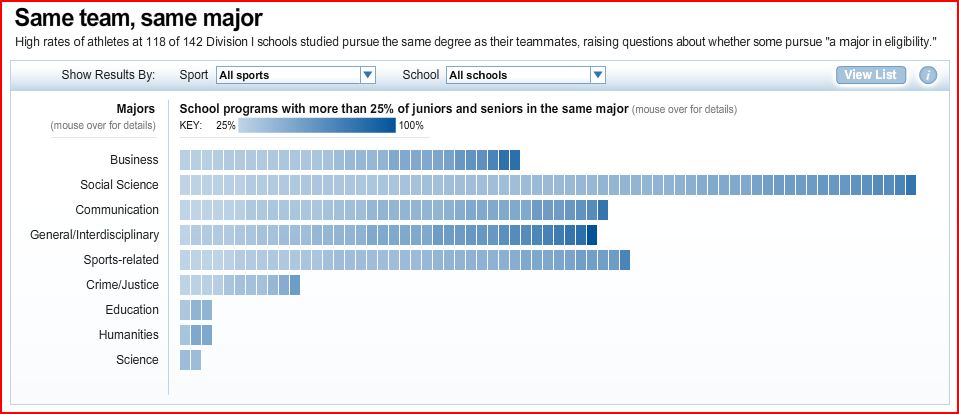
This screenshot features football players only. At Georgia Tech, 82 percent of football players major in Business:
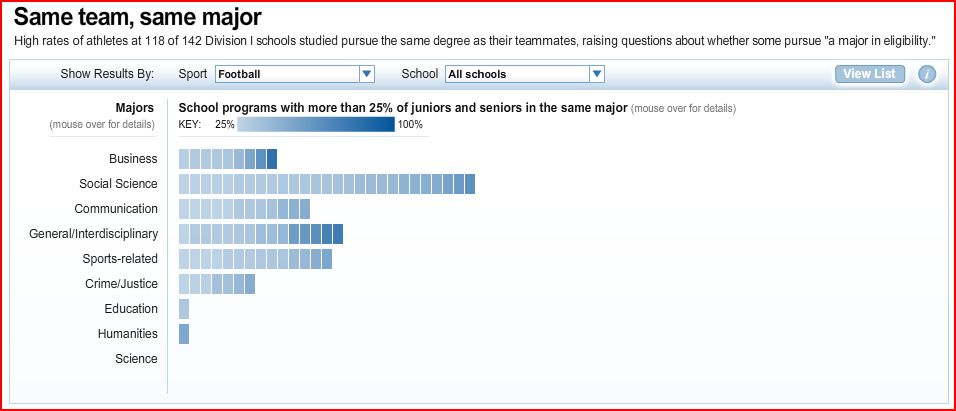
If you visit the site, you can manipulate the graphic as you like and see what school and team each rectangle represents.
Certain majors have long been rumored to be athlete friendly and I think this actual data sheds a lot of light on the false stereotype of both disciplines and athletes.
The article doesn’t speculate as to why teammates cluster, but we could…
I was recently speaking to a colleague at my College who remembered a time during which a good percentage of the football players majored in Sociology. He suggested that this was because one of the most high-profile football players, one who was very well-liked by his teammates and had a leadership role on the team, majored in Sociology. Since that player has left the College, the percent of football players in our major has decreased. In that sense, part of the explanation for why teammates cluster may be more social psychological than sociological.
What are your theories?
Burk sent in several Miller beer ads, all directed by Errol Morris, which contain some interesting messages about modern masculinity. Specifically, real men drink beer and don’t worry about stupid things like their diet or health:
This one connects drinking Miller to pro-American patriotism and the value of manpower (and it really means MANpower):
Real men know how to back up Suburbans pulling boats:
Clearly, we’ve lost an important element of manhood when men can no longer do this. Of course, driving a Suburban pulling a boat seems to contradict the whole patriotic non-use of gas element of manhood, but let’s not get into details.
And finally, real men have to restrain themselves while they listen to women:
It’s such a pain to have to interact with gals!
You can find even more here.
UPDATE: In a comment, Chuk says,
In these ads, with the exception of the cyclist, none of the men’s faces are ever fully shown. What if this was a series of adds with images of women? How would the regular poster and commentators normally react to this kind of framing? What would it mean in that context? Does that analysis apply to this context?
I think that’s a good question. One criticism people often make of ads is the way women’s faces are often obscured; this is pointed out as a way of objectifying them, turning them into bodies rather than full people with faces, voices, etc. I certainly think it’s possible to objectify men as well, although it’s also possible to show part of a body because the viewer is supposed to take on the viewpoint of the person in the ad, in which case you can’t, obviously, see the face or head, since you’re supposed to be the face/head. I found the bacon and butter burger ads creepy overall, as well as another one of the Morris ads where a (generally faceless) grandma is cooking for a bunch of men whose faces we never see.
Thanks for the comment, chuk!
Mercedes DeM. sent in this Vanity Fair cover (for April 2009)…
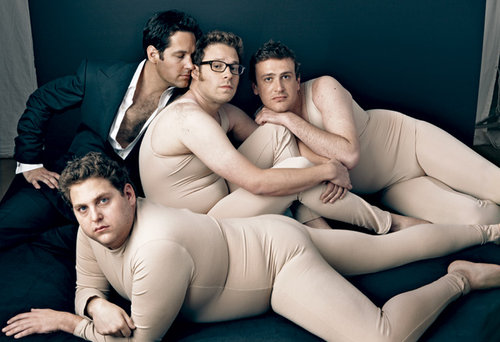
…spoofing this previous cover:
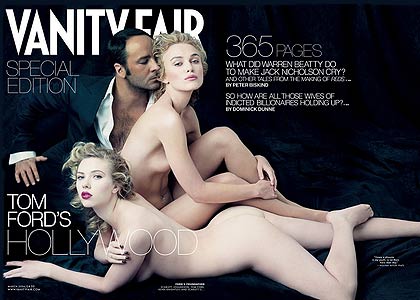
The women on the original cover are sex symbols. We should expect gratuitous nudity. The men in the spoof, in contrast, are comedians and so a direct comparison, arguing that men’s bodies are more off-limits, would be misguided. (Not that I think an argument couldn’t be made, but I don’t think this set of images supports it.)
Nor do I think that these images support the idea that we’re more accepting of variation in men’s bodies than women’s. If that were so, I think the men would actually be nude. Instead they’re covered up. My sense is that they’re covered up because their bodies are, according to rigid cultural standards, gross.
The relevant comparison, I think, would be between the spoof cover and a similar spoof cover featuring non-skinny women in nude body suits. The fact that the former is funny points to how men are allowed to be many things. They can be good-looking and fit, OR they can be not-so-good-looking, but rich, nice, or funny. And we still like them. There is no disdain for these men. We may even like them MORE because they’re willing to pose in ways that reveal how imperfect their bodies are.
I think we would be unlikely to see a similar cover featuring women, even women comedians, because women are allowed to be rich, nice, or funny but they must ALSO be good-looking and fit. A cover featuring chubby women would JUST be gross. It wouldn’t be gross and funny.
Being good-looking and fit is ONE way for men to be admire in our society. Being good-looking and fit is a REQUIREMENT for women to be admired, no matter what else she brings to the table.
I asked myself: in the entire history of Vanity Fair, would we be able to find three women with a similar body type to those men on the cover?
I found two, both featuring Roseanne Barr (images here and here):

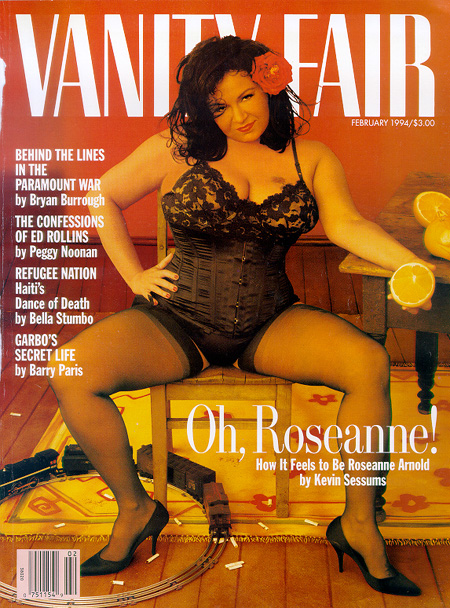
The covers feature a comedian who is well-known for being successful while bucking social expectations for women. She’s the exception to the rule that proves the rule. Or is she? I certainly think so. That “Oh, Roseanne!” is about how crazy she is.
In any case, notice that she’s still a sex symbol, while the men in the spoof are decidedly not. They’re spoofing such symbolism. Roseanne, despite her wacky resistance, still has to abide by it.